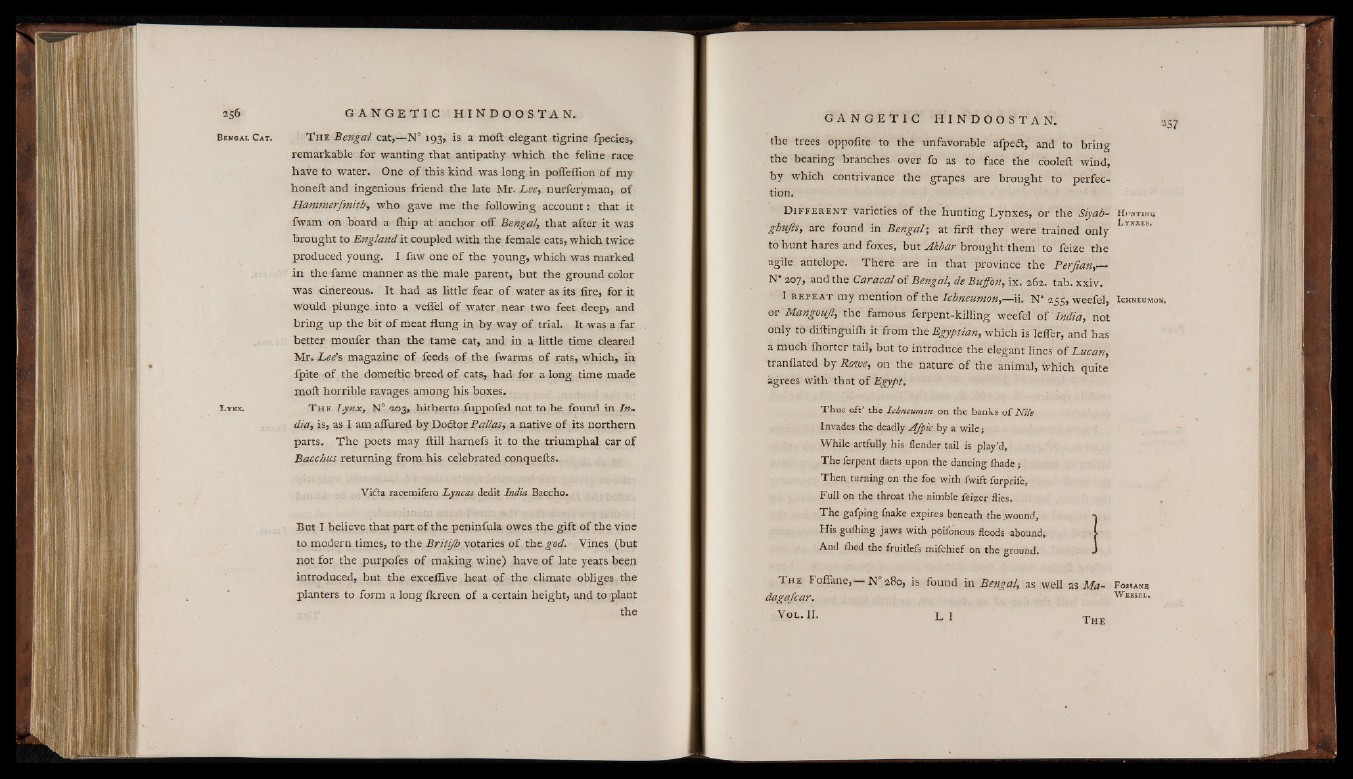
2$6
B engal C a t .
L ynx.
T h e Bengal cat,— N° 193, is a moil elegant tigrine fpecies,
remarkable for wanting that antipathy which the feline race
have to water. One o f this kind was long in pofleffion o f my
honeft and ingenious friend the late Mr. Lee, nurferyman, o f
Hammerfmitb, who gave me the following account: that it
iwam on hoard a ihip at anchor off Bengal, that after it was
brought to England it coupled with the female cats, which twice
produced young. I faw one of the young, which was marked
in the fame manner as the male parent, but the ground color
was cinereous. It had as little fear of water as its fire, for it
would plunge into a veflel o f water near two feet deep, and
bring up the bit o f meat flung in by way of trial. It was a far
better moufer than the tame cat, and in a little time cleared
Mr. Lee's magazine of feeds o f the fwarms o f rats, which, in
fpite of the domeftic breed o f cats, had for a long time made
moil horrible ravages among his boxes.
T he Lynx, N° 203, hitherto fuppofed not to be found in India,
is, as I am aflured by Doftor Balias, a native o f its northern
parts. T he poets may ftill harnefs it to the triumphal car o f
Bacchus returning from his celebrated conquefts.
Viita racemifero Lyncas dedit India Baccho.
Bat I believe that part o f the peninfula owes the gift of the vine
to modern times, to the Britijh votaries o f the god. Vines (but
not for the purpofes o f making wine) have of late years been
introduced, but the exceifive heat o f the climate obliges the
planters to form a long ikreen of a certain height, and to plant
the
G A N G E T I C H I N D O O S T AN. 237
the trees oppofite to the unfavorable afpedt, and to bring
the bearing branches over fo as to face the cooleit wind,
by which contrivance the grapes are brought to perfection.
D i f f e r e n t varieties o f the hunting Lynxes, or the Siyah- Hunting
ghujls, are found in Bengal', at firft they were trained only
to hunt hares and foxes, but Akbar brought them to feize the
agile antelope. There are in that province the Berjian,—
N" 207, and the Caracal of Bengal, de Buffon, ix. 262. tab. xxiv.
I r e p e a t my mention of the Ichneumon,— ii. N° 255, weefel, Ichneumon.
or Mangoujl, the famous ferpent-killing weefel of India, not
only to diftinguiih it from the Egyptian, which is lefier, and has
a much ihorter tail, but to introduce the elegant lines o f Lucan,
tranflated by Rowe, on the nature of the animal, which quite
agrees with that o f Egypt.
Thus oft’ the Ichneumon on the banks of Nile
Invades the deadly AJpic by a wile;
While artfully his flender tail is play’d,
The ferpent darts upon the dancing ihade;
Then, turning on the foe with fwift furprife,
Full on the throat the nimble feizer flies.
The gafping fnake expires beneath the wound,
His guihing jaws with poifonous floods abound,
And ihed the fruitlefs mifchief on the ground.
T h e Foflane, N° 280, is found in Bengal, as well as Ma- F ossanb
daga/car. W e e s e i ,